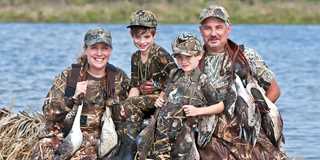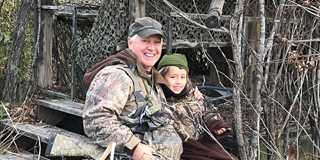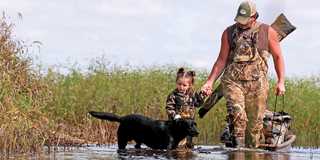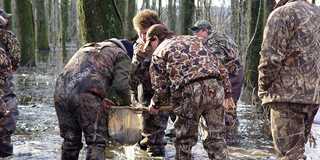Secrets of a Successful Youth Hunt
Here's how to create an unforgettable hunting experience for beginning waterfowlers
Here's how to create an unforgettable hunting experience for beginning waterfowlers

Photo TODDSTEELEPHOTOART.COM
Over time, memories of favorite mornings in the marsh become a part of a waterfowl hunter's soul, and perhaps no experience leaves a mark like that of a first hunt. For some young hunters, this means joining a family member or friend in the blind, while others get their first taste of a sunrise over the decoys thanks to the efforts of selfless volunteers. Whether you're taking along one youth or a dozen, the following tips will help you create a positive experience for beginning hunters, which will help ensure that they'll want to do it again and maybe even become waterfowlers for life.
Like any first hunting experience, a youth hunt should begin with plenty of thoughtful preparation and hands-on instruction. "There is a lot that goes on during a waterfowl hunt, and the experience can be a little overwhelming for young hunters. That is why it's so important to prepare them as much as possible before the hunt," explains Brian Schaffer, Outdoor Education Project administrator with the North Dakota Game and Fish Department.
Every aspect of the hunt should be carefully explained, including safety, hunting regulations, decoy placement, dog work, calling, concealment, and game processing. "You don't want there to be any surprises. Explain what the hunters will encounter step-by-step, from how to set decoys at the beginning of the hunt to cleaning and preparing the birds that are harvested," Schaffer says. "Be an open book for those new hunters. Explain what you're doing and why you're doing it."
The ultimate goal is to get the kids excited about the entire experience. "And don't be afraid to share why you get excited about it all," Schaffer adds. "Explain your traditions and why you fell in love with duck hunting."
Safety should be the top priority on any hunt, but it's of paramount importance when beginners are involved. Carefully explain to young hunters how to safely handle firearms. Key lessons should include maintaining muzzle control at all times, being aware of other hunters around you, keeping the safety on and fingers outside the trigger guard until it's time to shoot, and staying within your personal shooting lane.
"There is a lot of excitement after a duck falls, so before we send the dog or a volunteer steps out of the blind to retrieve the bird, we have each hunter check to make sure his or her safety is on and the muzzle is pointing in a safe direction. We also have them open the actions on their shotguns," Schaffer says. "It is a visual signal to everyone that it is now safe to retrieve the birds."
Schaffer adds that safety lessons should be tailored to the hunting scenarios kids will encounter in the field or marsh. "If they are going to be hunting from layout blinds, for example, have them practice sitting up and shooting clay targets from that position," Schaffer says. "Set them up to be safe and successful on their hunt."

Photo COURTESY OF RONAL ROBERSON
Ronal Roberson, DU's advisory senior vice president for youth and education, has organized and led youth hunts in his home state of Mississippi for many years. He believes that personal supervision provided by veteran hunters is essential on youth hunts. "Whether you're taking out your own children or grandchildren or a blind full of young kids on an organized youth hunt, you need experienced adults there to watch and observe those kids, keep them safe, help them learn, and hopefully help them have fun," he says.
The need for supervision is one reason Roberson tries to schedule hunts for kids during special youth waterfowl days, when experienced hunters will be more readily available to help. "Duck hunters love being in a duck blind, even if they aren't carrying a shotgun," he says. "And the people that are most passionate about duck hunting tend to love to share what they know, which is a good thing because those kids always have a lot of questions."

Photo JUSTIN THAYER
Another reason that Roberson likes to schedule hunts on youth waterfowl days is that duck clubs and other private landowners are more likely to open their properties to beginning hunters on those days than during the general waterfowl season. "The goal is to put kids in a target-rich environment, although it doesn't always work out that way," he says. "Having access to a high-quality hunting area will help ensure that you will see birds and get some shooting."
Blinds are another important consideration when choosing a location for a youth hunt. Roberson prefers large, comfortable blinds that can accommodate youth and adult volunteers and provide enough visibility for the kids to watch ducks working and dogs retrieving birds. It also helps if the blinds are easily accessible, preferably by boat or ATV.
"I did have one hunt, however, where a young boy and I had to walk across a stretch of gumbo to reach our blind, and I thought he was going to think this was the worst experience ever," Roberson recalls. "But he thought gumbo was the most amazing stuff. The mud was wearing me out, but to him it was all part of the fun."

Photo KATE VANDEMORE
Tony Vandemore, co-owner of Habitat Flats in north-central Missouri, hosts youth hunts every season on his property. In addition to providing instruction on shooting safety and basic waterfowl hunting skills, Vandemore says it's important to outfit kids with the right clothing and gear for their hunt. Fortunately, that's much easier than it used to be, as manufacturers now offer a wide selection of apparel and other hunting products designed specifically for youth.
"The new kid-friendly gear is much less bulky than what older hunters had to use when we were growing up," Vandemore says. "Without the extra clothing getting in the way, young hunters not only have an easier time mounting their shotguns, but their guns also fit better. In the end, they will be more comfortable, safer, and have a better chance of connecting on a shot if they have gear and clothing that fits."
Before the hunt, Vandemore allows the kids to pack their own blind bags, and he gives each hunter a waterfowl identification guide so they can look up the birds they see during the hunt. He also recommends having plenty of snacks on hand. "Or better yet, let the kids help you cook breakfast in the blind. That will probably be something they will never forget," Vandemore says. "Having something to eat helps pass the time in the blind when the birds aren't flying, and that's something that doesn't change as a hunter gets older."

Photo JIM THOMPSON
As on any waterfowl hunting trip, the weather is among the most important variables to consider when planning a youth hunt. Vandemore prefers to schedule hunts on youth waterfowl days that take place before the regular season opens. "The weather is usually mild, and there are often more locally raised birds and early migrants in the area, including blue-winged teal and wood ducks, which are really fun to hunt," Vandemore says. "Early Canada goose season is also a great time to put together hunts for kids."
If the weather is going to be cold, Vandemore recommends doing everything possible to keep the kids warm. "If they get cold, they aren't going to have much fun. Make sure you outfit them with warm coats, hats, gloves, and waders to keep the elements at bay. Run a heater, fill your thermos with hot chocolate, and stuff their pockets with handwarmers," he says. "And if the kids say they are ready to go, pack up and head back to the trucks."

Photo ANDI COOPER, DU
Vandemore, Roberson, and Schaffer all agree that adults shouldn't lose sight of the fact that the main objective of any youth hunt is to provide a fun experience for the kids. "Success should be measured from the perspective of the kids and not that of the adults who organized the hunt," Vandemore says. "Success to a kid might not be shooting a limit of mallards; it might be something as simple as eating donuts in the blind or catching bugs or frogs. The least important measure of success on a youth hunt should be the number of birds on a strap."
Schaffer adds that adults should be flexible and willing to change plans to keep the kids engaged. "Don't lose sight of the big picture," Schaffer says. "The kids need to be safe, but they should also have fun, which might mean letting them get out of the blind and walk around in the decoys or play with the dog."
For Roberson, taking kids hunting is a way to give back to the birds and the habitat that have meant so much to him over a lifetime of waterfowling. "I started hunting when I was eight years old, and I've seen thousands upon thousands of ducks in the flooded hardwoods and rice fields. Those experiences have been a blessing in my life, and now I want to share those same experiences with others, especially the kids," Roberson says. "That's what drives my work for youth, and that's why I try to make sure that every young person that comes along on a hunt has a positive experience."
And while the emphasis should always be on the young hunters, Roberson adds that everyone involved benefits from the time spent together outdoors. "You only have so many 'firsts' in your life, but every time you take a group of kids on their first hunt or you watch a boy or girl shoot his or her first duck, you get to be a part of it too," he says. "It's a very fulfilling experience."
Ducks Unlimited uses cookies to enhance your browsing experience, optimize site functionality, analyze traffic, and deliver personalized advertising through third parties. By continuing to use this site, you agree to our use of cookies. View Privacy Policy